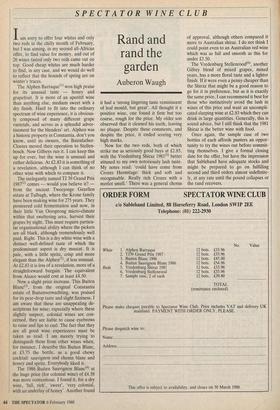SPECTATOR WINE CLUB
Rand and rand the garden
Auberon Waugh
Iam sorry to offer four whites and only two reds in the chilly month of February, but I was aiming, in my second all-African offer, to find value for money, and out of 26 wines tasted only two reds came out on top. Good cheap whites are much harder to find, in any case, and we would do well to reflect that the hounds of spring are on winter's traces.
The Alphen Barraque(1) won high praise for its unusual taste — honey and grapefruit. It is more of an aperitif wine than anything else, medium sweet with a dry finish. Hard to fit into the ordinary spectrum of wine experience, it is obvious- ly composed of many different grape varietals, and serves as a splendid adver- tisement for the blenders' art. Alphen was a historic property in Constantia, don't you know, until its owners, the Bairnfather- Cloetes moved their operation to Stellen- bosch. Now Gilbeys run it. I can keep this up for ever, but the wine is unusual and rather delicious. At £2.83 it is something of a revelation, although I can think of no other wine with which to compare it.
The inelegantly named Ti 39 Grand Prix 1987(2) comes — would you believe it? from the ancient Tweejonge Gezellen estate at Tulbagh, where the Krone family have been making wine for 275 years. They pioneered cold fermentation and now, in their little Van Oorsprong micro-climate within that sweltering area, harvest their grapes by night. This must require particu- lar organisational ability where the pickers are all black, although tremendously well paid. Right. This is a dry white wine with a distinct well-defined taste of which the predominant aspect is dry muscat. It is pale, with a little spitz, crisp and more elegant than the Alphen'), if less unusual. At £2.83 it is less of a revelation, more of a straightforward bargain. The equivalent from Alsace would cost at least £4.50.
Now a slight price increase. This Buiten Blanc(3), from the original Constantia estate of Buitenverwachting, was praised for its pear-drop taste and slight fizziness. I am aware that these are unappealing de- scriptions for wine; especially where these slightly suspect, colonial wines are con- cerned, they are liable to cause eyebrows to raise and lips to curl. The fact that they are all good wine experiences must be taken as read. I am merely trying to distinguish them from other wines when, for instance, I describe this Buiten Blanc, at £3.75 the bottle, as a good chewy cocktail: sauvignon and chenin blanc and honey and spritz. Everybody liked it. The 1986 Buiten Sauvignon Blanc(4) at the huge price (for colonial wine) of £4.58 was more contentious. I found it, for a dry wine, 'full, rich', 'sweet', 'very colonial, with an underlay of honey'. Another found it had a 'strong lingering taste reminiscent of leaf mould, but great'. All thought it a positive wine, one found it firm but too coarse, rough for the price. My older son observed that it cleaned his teeth, leaving no plaque. Despite these comments, and despite the price, it ended scoring very high marks.
Now for the two reds, both of which strike me as seriously good buys at £2.83, with the Vredenburg Shiraz 1981(5) better attuned to my own notoriously lush taste. My notes read: 'could have come from Crozes Hermitage: thick and soft and recognisable. Really rich Crozes with a merlot smell.' There was a general chorus of approval, although others compared it more to Australian shiraz. I do not think I could point even to an Australian red wine which was as full and smooth as this for under £3.50.
The Vredenburg Stellenrood(66, another Gilbey blend of mixed grapes, mixed years, has a more floral taste and a lighter finish. If it were even a penny cheaper than the Shiraz that might be a good reason to go for it in preference, but as it is exactly the same price, I can recommend it best for those who instinctively avoid the lush in wines of this price and want an uncompli- cated slurping wine at £2.83 which they can drink in large quantities. Generally, this is sound advice, but I still think that the 1981 Shiraz is the better wine with food.
Once again, the sample case of two bottles of each affords punters an oppor- tunity to try the wines out before commit- ting themselves. I give a formal closing date for the offer, but have the impression that Sablehand have adequate stocks and might be prepared to go on fulfilling second and third orders almost indefinite- ly, at any rate until the pound collapses or the rand recovers.


















































 Previous page
Previous page